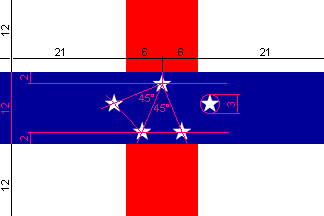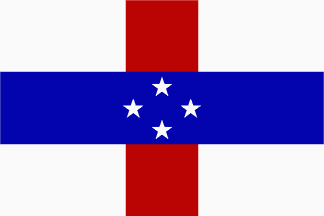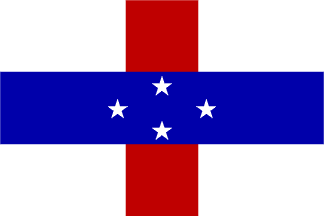![[Netherlands Antilles flag]](../images/a/an.gif) (2:3)
(2:3)image by Mark Sensen, 9 November 2003

Last modified: 2006-01-21 by dov gutterman
Keywords: netherlands antilles | nederlandse antillen | dutch realm | netherlands | antilles |
Links: FOTW homepage |
search |
disclaimer and copyright |
write us |
mirrors
![[Netherlands Antilles flag]](../images/a/an.gif) (2:3)
(2:3)
image by Mark Sensen, 9 November 2003
Official Name: Netherlands Antilles
(Nederlandse Antillen)
Previous Name: Curacao and Dependencies
Capital: Willemstad
Location: Caribbean
Government Type: Part of the Kingdom of the
Netherlands with Full Autonomy in Internal Affairs
Flag adopted: 1
January 1986
ISO Code: AN
Islands:
See also:
The postal administration of the Netherlands Antilles issued
(30 June 1995) six new stamps with the flags and the coats of
arms of the islands. The islands consist out of: Curacao,
Bonaire, St Maarten, Saba and St Eustatius. Only the last islands
don't have a flag and coat of arms of their own. St Eustatius
uses the flag and coat of arms of the Netherlands Antilles as its
national symbols. The Postal Service of the Netherlands Antilles
issued the booklet 'Flag Issue 1995 / Vlaggenserie 1995'
with full details on the history and use of the national symbols
of the islands.
Jos Poels, 4 August 1995
According to Album 2000 [pay00]
- Netherlands Antilles - The flag of the Netherlands Antilles is
white in proportions 2:3, on the center of the length a red
vertical stripe, and on the center of the height a blue
horizontal stripe across the red stripe. The width of both
stripes is one-third of the flag height. On the center of the
blue stripe are five white five pointed stars. The diameter of
the imaginary circle emscribing a star is one-fourth of the
height of the blue stripe. The colours red, white and blue refer
to the Dutch flag, the five stars symbolise the five islands.
Adopted by Country-Order of 31 December 1985, comming effective 1
January 1986. The First Flag was
adopted by Country-Order of 19 November 1959, and had six stars.
One star was dropped because Aruba left in
1986.
The centre of the topmost and bottommost stars are located at two
imaginary horizontal lines. The first line at one-sixth of the
height of the blue stripe under the upper edge of the blue
stripe, the second line at one-sixth of the height of the blue
stripe above the lower edge of the blue stripe. The centre of the
topmost star is located at the centre of the first imaginary
line. The centres of the bottommost stars are located on the
second imaginary line at such a way, that an isoscele triangle is
formed with the centre of the topmost star, with an angle of 45
degrees at the top. The centre of the leftmost star is located by
forming another isoscele triangle with the centre of the topmost
star and the centre of the left star at the bottom, again with an
angle of 45 degrees at the top. Likewise the centre of the
rightmost star is located.
Mark Sensen, 1 and 2 November 2003

image by Željko Heimer, 5 November 2003
.gif)
image from Ralf
Hartemink site
The politicians on Curacao, and also some on St.Maarten, now
wanted a Status Aparte as Aruba .
However, during referendums held in November 1993 (Curacao) and
October 1994 (Bonaire, St.Maarten, St.Eustatius and Saba) large
majorities of the people voted to remain part of the Netherlands
Antilles.
Apart from 1) the 'status quo' option and 2) Status Aparte,
there were 2 other options, both receiving very few votes: 3)
(overseas) province of the Netherlands; 4) full independence.
Mark Sensen, 4 May 1999
I read today in the International Herald Tribune that St. Maarten has just voted for separation
from Netherlands Antilles within the Kingdom of the Netherlands.
Well, I suppose the island will keep on flying its actual flag,
but there will probably be a new flag for Neth. Antilles, one of
the 5 stars having to be removed, if they follow the same logic
than they did in 1986 when Aruba broke away. The article I read
didn't say when the separation will happen.
Olivier Touzeau, 26 June 2000
First of all it was a consulting, non-binding referendum, the
other options apart from the favoured "status aparte"
(68.9%) being "status quo" (3.7%),
"independence" (14.2%), and "stronger position
within the Neth.Antilles" (11.6%).
Secondly, the Dutch politicians are not in favour of a Status
Aparte for Sint Maarten. And when Sint Maarten will leave the
Neth.Antilles, the question is what Sint Eustatius and Saba will
do. There is e.g. a majority on Saba that wants to become a
province of the Netherlands in that case.
Source: Amigoe.com
Mark Sensen, 26 June 2000
Looking at a map, one has the distinct impression that the
whole thing is completely wrong: Aruba, Bonaire and Curacao are
just north of Venezuela, and 1000 km to NE are Sint Maarten, Sint
Eustatius and Saba. That's the geographical setting.
But the political divisions are Aruba as a separate territory and
the Dutch Antilles covering everything else. Now, if Sint Maarten
breakes away to a status of separate autonomy, things will become
even more strange.
Antonio Martins, 28 June 2000
Today, the report "The time is now, let’s do
it!" (so-called Jesurun Report) with plans for reformation
of the Netherlands Antilles was presented to Kingdom Relations
Minister Thom de Graaf. It includes the next idea for a
new political division:
1. The country Netherlands Antilles will cease to exist
2. Curacao and St. Maarten will both receive the status of
autonomous country within the Kingdom (like Aruba already has
since 1986)
3. Bonaire, St. Eustatius and Saba will each receive the status
of "Koninkrijkseiland" ("Kingdoms Island")
More info (in Dutch) at the website of the Ministry of the
Interior and Kingdom Relations at <www.minbzk.nl>.
Final decisions about the adoption of the plans will probably be
taken at a Round Table Conference in 2005. If the
reformations will take place it will have effect on some flags:
- the flag of the Netherlands Antilles, as well as the flag of
the gouvernour of the Netherlands Antilles, will be abolished
- flags for the gouvernours of Curacao and St. Maarten will
(probably) be introduced.
Mark Sensen, 8 October 2004
The proposed new four-starred flag for the
Netherlands Antilles will not be adopted as not only is
Sint-Maarten seceding, so is Curaçao. The Dutch government has
announced plans for both islands to leave the Netherlands
Antilles and although no firm timetable is announced it is likely
that the change will take in 2005 or 2006. Both Curaçao and
Sint-Maarten will have the same wide-ranging autonomy that is
presently enjoyed by Aruba, which withdrew from the Netherlands
Antilles in 1986. The three remaining small poorly populated
islands of the (reduced) Netherlands Antilles will have a new
status, without the responsible government - legislature, Prime
Minister and Council of Ministers - that will exist in Aruba,
Sint-Maarten, and Curaçao. Both Curaçao and Sint-Maarten, of
course, already have flags.
Clive Carpenter, 22 November 2004
Today's edition of The Times newspaper carries an obituary for
Bernard Komproe, who only recently became the Prime Minister of
the Netherlands Antilles, or the Antilles Federation, as it has
been more recently known as.
In conclusion, the obituary states: Coincidentally, an official
proposal to end the Antilles Federation, backed by both the Dutch
and Antilles Governments, has just been made public. It is
considered very likely to be agreed, and a round- table
conference next Spring will discuss details. For international
purposes, the official designation of all the former Dutch
colonies in the Caribbean, together with The Netherlands itself,
remains The Kingdom of The Netherlands. Curacao, and St. Maarten,
with Aruba (which seceded from the federation in 1986), will
enjoy separate status. The smaller states of Saba, St. Eustatius,
and Bonaire have opted for a status close to that of a province
of The Netherlands.
Ron Lahav, 22 November 2004
Note that The Times writes about the "Netherlands
Antilles federation", so federation with a small
"f". In other words, the Netherlands Antilles are still
the Netherlands Antilles, not the Antilles Federation. See also
my message of 8 October 2004.
Mark Sensen, 22 November 2004
Coincidentally, an official proposal to end the Antilles
Federation, backed by both the Dutch and Antilles Governments,
has just been made public. It is considered very likely to be
agreed, and a round- table conference next Spring will discuss
details.
From Intelligence Research Ltd, October 12, 2004:
"Recolonisation initiatives are a rare occurrence, and even
rarer are those with a chance of prospering. The Netherlands
Antilles may become such a rarity. The special commission set up
by the governments of the Netherlands and the Netherlands
Antilles, under the direction of former Antillean governor Edsel
Jesurun, has recommended breaking up this entity and returning
three of its smallest components - Saba, Bonaire and Sint
Eustatius - to direct rule from The Hague. Curacao and
Sint Maarten would be given the same status as the earlier
breakaway, Aruba: autonomous countries within the Dutch Kingdom,
alongside the Netherlands. This would spell the disappearance of
the central government of the Netherlands Antilles (much of it
would be subsumed into the new government of Curacao), but the
commission recommends retaining, under a 'cooperative'
arrangement, such institutions as the central bank, the social
security bank and the pension funds. Though the
recommendations are not binding, both of the commissioning
governments have said they would 'weigh heavily' on their
decisions. The Jesurun commission has counselled speed: a formal
political agreement between both countries by the end of this
year, a conference in mid 2005 to sort out the constitutional
aspects (which entail changes to the Kingdom Charter and the
Islands Regulation, and presumably the scrapping of the Antillean
Constitution, plus the groundwork for the new constitutions of
Curacao and Sint Maarten). Along the line, there will have
to be discussions on the financial aspects of such matters as
providing security for the new autonomous countries; the
commission specifically cites security needs as one of the
reasons for the overhaul."
David C. Fowler, 23 November 2004
El Caribe, the principal daily newspaper in the
Dominican Republic, reports that the Netherlands Antilles will be
dissolved in 2007.
Ron Lahav, 28 November 2005
See my message of 8 October 2004. Saterday the start of Round
Table Conference mentioned at that post took place.
Nothing new, apart from the fact that the new status for Bonaire,
St. Eustatius and Saba isn't called "Koninkrijkseiland"
("Kingdoms Island") but a new status of special nature
("sui generis"). The aim is for 1 July 2007 for the
political changes to take effect. For more info (in Dutch)
see the official website of the Dutch Ministry of the Interior
and Kingdom Relations at <www.minbzk.nl>.
Mark Sensen, 28 November 2005
have browsed that site a bit, and there was little information
about the new status. Even the recent referenda on all islands
are not mentioned. The Antillians were presented several options
and the islands of Curaçao, Bonaire and St. Maarten opted for a
"status aparte", like Aruba has now. Saba for something
else, so in future the Netherlands Antilles will consist of St.
Eustatius only. In fact The Netherlands want to get rid of the
Netherlands Antilles, and the Netherlands Antilles want to become
either the 13th province of The Netherlands, or even a
municipality like Urk or Schiermonnikoog. At present it seems
impossible to see what will happen next.
Jarig Bakker, 29 November 2005

image by Juan Manuel Gabino Villascan, 26 Febuary 2002
According the results of the referendum held in June 23, 2000,
in Sint Maarten (the Netherlands part of the Caribbean island of
Saint Marten), this territory is becoming a "new country
within the Kingdom of the Netherlands", in other words, Sint
Maarten is seceding from Netherlands Antilles. This is taking
place on nest 1 June 2002.
The question is if will keep the Neth. Antilles the same flag or
will it change?
According information requested by myself to the government of
the Neth. Antilles, via e-mail, the flag will be changed: to the
current flag will be drop off a star, remaining four, one for
each component island: Curacao, Bonaire, Saba and Saint
Eustatius. The stars are displaying like a rhombus.
Juan Manuel Gabino Villascan, 26 Febuary 2002

image by Juan Manuel Gabino Villascan, 27 Febuary 2002
This a variant of the future Netherlands Antilles flag to be
adopted on June 1, 2002, when Sint Maartin seced from it. The
lateral (near-hoist and near-fly) stars are more separated,
remarking the rhombus shape.
Juan Manuel Gabino Villascan, 27 Febuary 2002
Although there was a majority for a "status aparte"
in the (consulting) referendum, and there have been some talks I
think with the rest of the Netherlands Antilles, I never heard
the new status was granted >However, to be sure I mailed the
Dutch Ministry of the Interior and Kingdom Relations and a
newspaper on the Neth. Antilles. When I receice an answer I will
forward it.
Mark Sensen, 27 Febuary 2002
I don't have an answer from the ministry yet. But I received
one from the newspaper Amigoe at Curacao, and they don't know
anything about it. I also got an answer from Jos Poels who is in
contact with a journalist working for a Dutch newspaper in
Curacao. He wrote it's very unlikely a Status Aparte ever will be
given.
Mark Sensen, 1 March 2002

Habitat Curaçao Seahorse Flag
image from <www.habitatdiveresorts.com>

Habitat Bonaire Pirate flag
image from <www.habitatdiveresorts.com>
On <www.uitgeverijwvdoever.nl> (defunct) was a flag
without any explanation, just "Habitat Curaçao - Curaçao,
Netherlands Antilles". At <www.habitatdiveresorts.com/curacao>
the same flag and an advertisement for a local resort, aiming to
keep diving clean. At <www.habitatdiveresorts.com>
the flag is waving, along with a kind of pirate flag, and a bit
of info: "Capt. Don Stewart, founder of Habitat, is
recognized worldwide as a leader in the movement to protect our
underwater environment. Shortly after arriving on Bonaire in May
of 1962 he opened the island's very first dive operation. In 1977
he created Capt. Don's Habitat and pioneered the "Diving
Freedom" concept which each year continues to further
Habitat's reputation for providing fun, safe and innovative dive
vacations."
The pirate flag is the flag of Habitat Bonaire.
Jarig Bakker, 10 June 2003
Red background with descending white sword diagonally (common
part of both flags) surely makes me think of scuba diving and
snokerling.
Anto'nio Martins, 12 June 2003